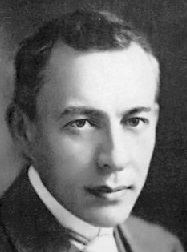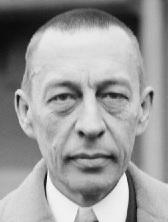Sergey Rachmaninoff
Sergey Vasilyevich Rachmaninoff (born March 20, 1873, died March 28, 1943) was a Russian composer who was the last great figure in the tradition of Russian Romanticism and a leading piano virtuoso of his time.
He is especially known for his piano concerti and the piece for piano and orchestra titled Rhapsody on a Theme of Paganini (1934).
Early life
Rachmaninoff was born on an estate belonging to his grandparents, situated near Lake Ilmen in the Novgorod district.
His father was a retired army officer and his mother was the daughter of a general.
The boy was destined to become an army officer until his father lost the entire family fortune through risky financial ventures and then deserted the family.
 Young Sergey’s cousin Aleksandr Siloti, a well-known concert pianist and conductor, sensed the boy’s abilities and suggested sending him to the noted teacher and pianist Nikolay Zverev in Moscow for his piano studies.
Young Sergey’s cousin Aleksandr Siloti, a well-known concert pianist and conductor, sensed the boy’s abilities and suggested sending him to the noted teacher and pianist Nikolay Zverev in Moscow for his piano studies.
It is to Zverev’s strict disciplinarian treatment of the boy that musical history owes one of the great piano virtuosos of the 20th century.
For his general education and theoretical subjects in music, Sergey became a pupil at the Moscow Conservatory.
At age 19 he graduated from the conservatory, winning a gold medal for his one-act opera Aleko (after Aleksandr Pushkin’s poem Tsygany [“The Gypsies”]).
His fame and popularity, both as composer and concert pianist, were launched by two compositions: the Prelude in C-sharp Minor, played for the first time in public on September 26, 1892, and his Piano Concerto No. 2 in C Minor, which had its first performance in Moscow on October 27, 1901.
The former piece, although it first brought Rachmaninoff to public attention, was to haunt him throughout his life—the prelude was constantly requested by his concert audiences.
The concerto, his first major success, revived his hopes after a trying period of inactivity.
In his youth, Rachmaninoff was subject to emotional crises over the success or failure of his works as well as his personal relationships.
 Self-doubt and uncertainty carried him into deep depressions, one of the most severe of which followed the failure, on its first performance in March 1897, of his Symphony No. 1 in D Minor.
Self-doubt and uncertainty carried him into deep depressions, one of the most severe of which followed the failure, on its first performance in March 1897, of his Symphony No. 1 in D Minor.
The symphony was poorly performed, and the critics condemned it. During this period, while brooding over an unhappy love affair, he was taken to a psychiatrist, Nikolay Dahl, who is often credited with having restored the young composer’s self-confidence, thus enabling him to write the Piano Concerto No. 2 (which is dedicated to Dahl).
Major creative activity
At the time of the Russian Revolution of 1905, Rachmaninoff was a conductor at the Bolshoi Theatre.
Although more of an observer than a person politically involved in the revolution, he went with his family, in November 1906, to live in Dresden.
There he wrote three of his major scores: the Symphony No. 2 in E Minor (1907), the symphonic poem The Isle of the Dead (1909), and the Piano Concerto No. 3 in D Minor (1909).
 The last was composed especially for his first concert tour of the United States, highlighting his much-acclaimed pianistic debut on November 28, 1909, with the New York Symphony under Walter Damrosch.
The last was composed especially for his first concert tour of the United States, highlighting his much-acclaimed pianistic debut on November 28, 1909, with the New York Symphony under Walter Damrosch.
Piano Concerto No. 3 requires great virtuosity from the pianist; its last movement is a bravura section as dazzling as any ever composed.
In Philadelphia and Chicago, he appeared with equal success in the role of conductor, interpreting his own symphonic compositions.
Of these, Symphony No. 2 is the most significant: it is a work of deep emotion and haunting thematic material.
While touring, he was invited to become a permanent conductor of the Boston Symphony, but he declined the offer and returned to Russia in February 1910.
The one notable composition of Rachmaninoff’s second period of residence in Moscow was his choral symphony The Bells (1913), based on Konstantin Balmont’s Russian translation of the poem by Edgar Allan Poe.
This work displays considerable ingenuity in the coupling of choral and orchestral resources to produce striking imitative and textural effects.
Later years
After the Russian Revolution of 1917, Rachmaninoff went into his second self-imposed exile, dividing his time between residences in Switzerland and the United States.
Although for the next 25 years he spent most of his time in an English-speaking country, he never mastered its language or thoroughly acclimatized himself.
With his family and a small circle of friends, he lived a rather isolated life.
He missed Russia and the Russian people—the sounding board for his music, as he said.
And this alienation had a devastating effect on his formerly prolific creative ability.
He produced little of real originality but rewrote some of his earlier work.
Indeed, he devoted himself almost entirely to concertizing in the United States and Europe, a field in which he had few peers.
His only substantial works from this period are the Symphony No. 3 in A Minor (1936), another expression of sombre, Slavic melancholy, and the Rhapsody on a Theme of Paganini for piano and orchestra, a set of variations on a violin caprice by Niccolò Paganini.
Rachmaninoff’s last major work, the Symphonic Dances for orchestra, was composed in 1940, about two years before his death.
Legacy
Rachmaninoff’s music, although written mostly in the 20th century, remains firmly entrenched in the 19th-century musical idiom.
He was, in effect, the final expression of the tradition embodied by Tchaikovsky—a melodist of Romantic dimensions still writing in an era of explosive change and experimentation.
–
Piano Concerto No. 1 in F sharp minor, Op. 1
The work is in three movements:
Vivace
Andante cantabile
Allegro scherzando
In the video, the concerto is performed by Anna Fedorova with the Symphony Orchestra Sankt Gallen conducted by Modestas Pitrenas. The concert took place in the Concertgebouw in Amsterdam, Sunday the 2nd of February 2020.
–
Piano Concerto No. 2 in C minor, Op. 18
This piece is one of Rachmaninoff’s most enduringly popular pieces and established his fame as a concerto composer.
The movements are:
I. Moderato
II. Adagio sostenuto
III. Allegro scherzando
In the video, the concerto is performed by Anna Fedorova with Nordwestdeutsche Philharmonie conducted by Martin Panteleev. The concert took place in the Concertgebouw in Amsterdam, on 1 September 2013.
Here is another video performance of the concerto by Evgeny Kissin with the Orchestre Philharmonique de Radio France conducted by Myung-Whun Chung. the concert took place in Salle Pleyel, Paris, on 19 September 2014.
–
Piano Concerto No. 3 in D minor, Op. 30
The piece was premiered on November 28, 1909, in New York City with the composer as soloist, accompanied by the New York Symphony Society under Walter Damrosch. The work often has the reputation of being one of the most technically challenging piano concertos in the standard classical piano repertoire.
The movements are:
(00:20) I. Allegro ma non tanto
(16:52) II. Intermezzo: Adagio
(26:20) III. Finale: Alla breve
In the video, the concerto is performed by Khatia Buniatishvili with the Verbier Festival Orchestra conducted by Neeme Järvi. The concert took place at the Verbier Festival in 2011.
–
Piano Concerto No. 4 in G minor, Op. 40
The movements are:
– Allegro vivace (0:26)
– Largo (11:57)
– Allegro vivace (20:14)
In the video, the concerto is performed by Viktoria Postnikova with the Iceland Symphony Orchestra conducted by Gennady Rozhdestvensky. The concert took place in Harpa, Reykjavik, on April 30th, 2015.
–
Symphony No. 1 in D minor, Op. 13
Despite its poor initial reception, the symphony is now seen as a dynamic representation of the Russian symphonic tradition, with British composer Robert Simpson calling it “a powerful work in its own right, stemming from Borodin and Tchaikovsky, but convinced, individual, finely constructed, and achieving a genuinely tragic and heroic expression that stands far above the pathos of his later music.”
The movements are:
Grave—Allegro non troppo (D minor)
Allegro animato (F major)
Larghetto (B♭ major)
Allegro con fuoco (D major)
In the video, the symphony is performed by Netherlands Radio Philharmonic Orchestra conducted by Stanislav Kochanovsky.
–
Symphony No. 2 in E minor, Op. 27
This symphony remains one of the composer’s best-known compositions.
The movements are:
I. Largo – Allegro Moderato 0:00
II. Allegro molto 19:18
III. Adagio 29:30
IV. Allegro vivace 44:34
In the video, the symphony was performed by the Oslo Philharmonic Orchestra conducted by Vasily Petrenko in the Oslo Concert Hall on 31st October 2014.
–
Symphony No. 3 in A minor, Op. 44
In melodic outline and rhythm, this is Rachmaninoff’s most expressively Russian symphony, particularly in the dance rhythms of the finale.
The movements are:
Mvt. I) Lento – Allegro moderato – Allegro
Mvt. II) Adagio ma non troppo – Allegro vivace
Mvt. III) Allegro – Allegro vivace – Allegro (Tempo primo) – Allegretto – Allegro vivace
In the video, the symphony was performed by the American Youth Symphony Orchestra conducted by Carlos Izcaray in UCLA’s Royce Hall.
–
Symphonic Dances, Op. 45
This is Rachmaninoff’s final composition. It is the only piece he composed in its entirety while living in the US.
The movements are:
I. Non allegro – Lento – Tempo I
II. Andante con moto (Tempo di valse)
III. Lento assai – Allegro vivace – Lento assai come prima – Allegro vivace
In the video, the Symphonic Dances are performed by the Frankfurt Radio Symphony Orchestra conducted by Andrés Orozco-Estrada. The concert took place at the Alte Oper, Frankfurt, 7. February 2014.
–
Rhapsody on a Theme of Paganini, Op. 43
This is a set of 24 variations on the twenty-fourth and last of Niccolò Paganini’s Caprices for solo violin.
In the video, the rhapsody is performed by pianist Anna Fedorova with Philharmonie Südwestfalen conducted by Gerard Oskamp. The concert took place on Sunday the 11th of March 2018 in the Concertgebouw in Amsterdam.


